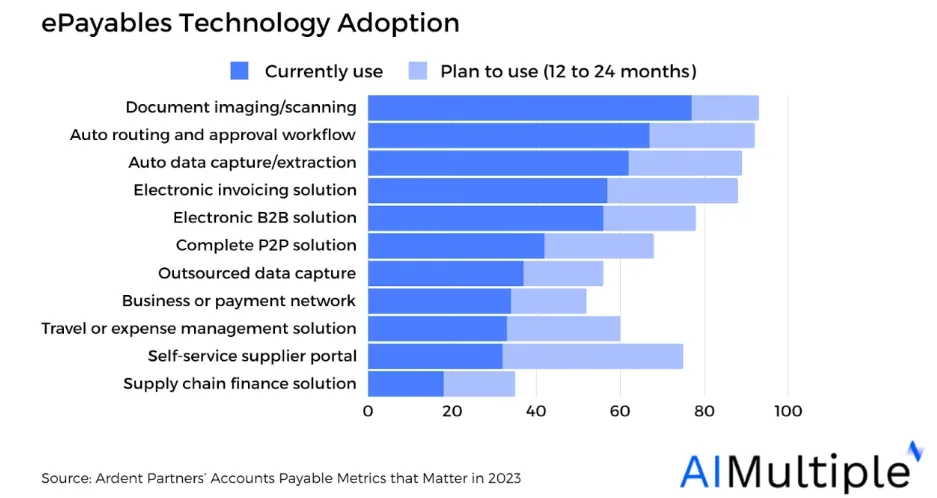Topics: Accounts Payable Automation, Accounts Payable Process
2025 Guide to Mastering Accounts Payable Internal Controls
Posted on February 26, 2025
Written By Priyanka Rout

Imagine this: You’re planning a family vacation. You book your flights, hotels, and activities, making sure every payment aligns with your budget. Now, imagine discovering you accidentally paid for the hotel twice because you didn’t double-check the confirmations.
Frustrating, right? This scenario mirrors the challenges businesses face without robust Accounts Payable internal controls. Just as double bookings can disrupt vacation plans, duplicated payments can wreak havoc on a company’s finances.
Accounts Payable (AP) internal controls are like the checks and balances in your travel itinerary—they ensure that every transaction is authorized, recorded, and executed correctly.
As we move into 2025, staying sharp with these controls is more than just nice to have—it’s crucial. This guide isn’t just about avoiding mistakes; it’s about streamlining your entire financial process to make it as smooth as your dream vacation should be.
What Exactly Are Accounts Payable Internal Controls?
Think of accounts payable internal controls as your financial playbook. They’re the steps your team follows to handle debts smartly and smoothly. These controls fall into three main areas:
- Knowing When to Pay: Figuring out when it’s time to shell out cash.
- Entering the Details: Making sure all the payment info gets into your system correctly.
- Making the Payment: The part where you actually send the money.
Why fuss over these steps? Because they keep your business ticking. They help you avoid mistakes that can cost you money, make sure your team runs like a well-oiled machine, and ensure you pass audits with flying colors.
Here’s the deal with accounts payable:
- You want to pay up on time to keep your suppliers happy.
- You need to make sure every penny spent is spot on.
Getting this balance right is crucial. Speed through payments too fast, and you might end up paying some bills twice. Take too long checking every detail, and you could miss payment deadlines.
That’s why strong procurement controls in your procure-to-pay process are a game changer. They set up a foolproof system that helps you dodge duplicates, prevent fraud, stick to the rules, and cut down on slip-ups.

Sure, most places have some controls in place, but there’s always space to level up. It’s worth taking a deep dive into how things are done to spot any weak spots or chances to get better. Thanks to the latest tech in accounts payable, lots of tasks that used to be manual can now be automated, making life easier and your numbers more reliable.
Why Your Business Really Needs Internal Controls
Here’s a quick rundown on why internal controls for accounts payable (AP) are a big deal:
- Kick Fraud to the Curb – Did you know? In 2018, about 82% of companies dealt with some form of fraud, based on a report from the AFP Payments Fraud and Control. That’s not just a fluke—it’s a part of a growing trend. As these external threats ramp up, beefing up your AP processes is more crucial than ever.
- Less Risk, More Peace of Mind – More controls mean more people keeping an eye on things, slashing your risk right down. Spreading out the responsibility means no single point of failure, creating a safety net for your finances.
- Hit the Mark on Accuracy – When your AP is dialed in—especially with automated systems—you’re going to see your accuracy shoot through the roof. That’s great for keeping your books tight and your decisions sharp.
- Everyone Shares the Load – By splitting up duties, no one person gets bogged down with all the financial weight. It’s all about teamwork here, which means better oversight and less chance of something slipping through the cracks.
- Keep Suppliers Happy – Late payments? They’re a quick way to sour relationships with suppliers. Solid AP controls mean you’re paying on time or even early, keeping those relationships smooth and maybe even snagging some early payment discounts.
- Audit-Ready All the Time – With strong controls in place, audits are a breeze. No more scrambling to explain discrepancies like duplicate payments or missed deadlines. Everything is organized and ready for review, making audit time a walk in the park.
Discover how we transformed the accounts payable process for a leading global beverage producer and distributor. Dive into our case study to see the real-world impact of AP optimization!
What Are the Types of Accounts Payable Internal Controls
1. Obligation to Pay Controls: Before you even think about paying a bill, you need to be sure it’s legit and actually yours to pay. Here’s how you make sure of that:
- Invoice Approval: Someone needs to give the thumbs up on each invoice. But here’s the catch: approving an invoice without confirming the goods have arrived is like signing a blank check. You need evidence like a receiving report to back it up.
- Purchase Order Approval: Whenever your company buys something, the purchasing department must issue a purchase order (PO). This document is crucial as it officially says, “Yes, we need this, and it’s okay to spend the money.” It’s a way to keep spending in check and make sure no money goes where it shouldn’t.
- Three-way Matching: This step ties everything together. You’ve got your invoice, your PO, and your proof of delivery. Matching these three ensures that what you’re paying for is exactly what you ordered and received. It’s a solid way to safeguard against paying for things you never got.
- Four-way Matching: Take three-way matching up a notch by adding an inspection report. This is used mostly when goods need to be inspected upon arrival. It’s all about double-checking that not only did the items arrive, but they also meet the quality standards you expect.
2. Auditing for Duplicates: Ever worry about paying the same invoice twice? That’s where auditing comes in. Using software—or the old-fashioned way by manually checking—helps catch any duplicates before they turn into double payments.
The Nuts and Bolts of the Process
When dealing with paperwork like supplier invoices and POs, traditionally, you’d gather all documents together, ensuring the invoice is stamped with the right account for charging. This packet helps whoever’s approving the payment to have all the info needed.
However, switching to AP automation software can speed this up by managing documents electronically and guiding the approval process along predefined routes.
What are the Common Challenges with Internal Control Systems
Internal control systems are essential, but they’re not without their challenges. Here’s a look at some common issues:
- Balancing Act Between Efficiency and Control – While internal controls are vital for auditing and securing processes, they can sometimes slow things down. This trade-off between control and efficiency is a tricky balance. Companies must weigh the need for tight controls against the desire for smooth, efficient operations. Efficiency is important, but it’s not the only marker of a company’s success.
- Risk Management vs. Strategic Agility – Implementing robust internal controls often requires management to accept some level of risk. This is part of designing a strategic profile that enhances competitiveness. The goal is to reduce risks without stifling the company’s ability to react quickly and effectively in the market.
- Challenges of Manual Systems – Smaller operations often rely on manual accounting, which can be risky. Manual processes are prone to human error and lack the transparency of fintech or automated systems.
- The Tradeoffs – Internal controls involve tradeoffs. While necessary for maintaining checks and balances, they can lead to decreased morale if not managed well. Employees might feel bogged down by the controls, which can affect their performance and satisfaction at work.
- Temptation to Cut Corners – Another issue arises when internal controls delay processes. Employees under pressure to meet deadlines might skip steps or ignore rules, increasing the financial risk to the organization. This is especially problematic if employees don’t fully understand the importance of these controls or choose to bypass them altogether.
- Compliance and Understanding – For internal controls to be effective, everyone needs to be on board. If an employee doesn’t understand the procedures or chooses to ignore them, it undermines the entire system. This can lead to inaccuracies in accounting and increase the risk of serious issues like fraud.
How to Set Up an Internal Controls Framework for Accounts Payable
Accounts Payable (AP) plays a vital role in managing the outflow of funds from a business. Once payments are made to suppliers, reversing them is as tricky as trying to put water back into a broken pipe. This is why establishing a strong internal controls framework is crucial to guard against payment errors and fraud.
Mistakes in data entry and fraudulent payments can and do occur. Setting up a robust AP controls framework involves creating defined approval workflows, assigning signatory rights, and implementing stringent payment processes to ensure financial transactions comply with regulatory standards before any money leaves the company.
1) Assigning Roles and Responsibilities
Effective internal controls in AP start with clear roles and responsibilities from the top down—from the CFO to the Controller to the AP clerks.
- Leadership Influence: Senior staff not only set the organizational tone but also ensure duties are segregated to prevent any single person from controlling funds unilaterally. This segregation helps catch errors and prevent unauthorized fund releases.
- Approval Workflows: Implementing and automating approval workflows for transactions with suppliers ensures checks are in place before any payment is finalized. This not only secures transactions but also keeps a digital trail for auditing purposes.
2) Implementing a Thorough Supplier Onboarding Program
Knowing your suppliers is essential, especially for cross-border relationships where monitoring is more challenging. A thorough onboarding process might include verifying business addresses and banking details for electronic payments.
Regulations like the Foreign Account Tax Compliance Act (FATCA) help by requiring detailed documentation from suppliers, aiding in compliance and tax issues.
3) Utilizing Known Blacklists
Regularly checking suppliers against the OFAC SDN list ensures that no payments go to entities blacklisted for illegal activities, thus minimizing risks associated with fraud and money laundering. For businesses with high supplier turnover, maintaining an internal database for regular checks can be beneficial.
4) Proactive Fraud Detection Measures
A basic but crucial internal control is conducting detailed and regular payment reconciliations. Promptly reporting all transactions back to the general ledger or ERP system helps in early detection of discrepancies. Delaying this to month-end gives potential fraudsters a lengthy head start to cover their tracks.
Best Practices to Simplify Your Accounts Payable Internal Controls
Running a business without solid internal controls is like leaving the doors unlocked to your most valuable assets. Even if you’re working with limited resources, there are straightforward steps you can take to safeguard your operations.
| TYPE OF CONTROL | FUNCTION | OBJECTIVE | TYPICAL APPLICATIONS |
|---|---|---|---|
| Detective | Identify errors or irregularities after they occur | To ensure problems are caught and assessed | Reconciliation reviews, regular audits, compliance checks |
| Preventive | Stop errors or fraud before they happen | To prevent issues from occurring | Setting spending limits, segregating duties |
| Corrective | Address and resolve errors found | To fix issues and prevent recurrence | Adjusting processes, updating controls after audits |
Looking to speed up your month-end close? Check out our blog on ’12 Ways to Streamline Your Month-End Close in Accounts Payable’ and start simplifying your process today!
BONUS: Easy Ways to Kickstart Internal Controls in Your AP
Setting up internal controls in your accounts payable doesn’t need to be expensive or super complicated. Here are some straightforward tips to help you get the ball rolling:
- Checklist Is Your Friend: Whip up a simple checklist of the internal controls you need. It’s a great way to make sure you don’t miss anything important.
- Cap Those Transactions: Put caps on how much can be spent without extra eyes checking it out. Have managers sign off on anything that goes over the limit.
- Spread the Knowledge: Make sure a couple of people know how to handle everything in AP. This way, if someone’s out sick or leaves the job, you’re covered.
- Monthly Money Check-Ups: Take time each month to go through accounts like cash, receivables, payables, inventory, and payroll. Better yet, get someone outside your team to take a look too—it’s a smart way to catch any oops moments.
- Keep It Exclusive: Limit who can get into your general ledger. Fewer hands in the pot, fewer chances for mistakes.
- Eye on the Entries: Have someone check over all the journal entries regularly, especially the ones that don’t follow the usual routine.
- Update Your Vendors: Keep your vendor list fresh and accurate. It’s simple but super effective in keeping things smooth and secure.
- Credit Rules: Set up a clear policy for customer credit and review it often. Knowing who can spend what and when is key.
Tip: You don’t have to do everything at once. Pick a couple of these strategies, implement them, and see how they go. You can always add more as you get comfortable. Before you know it, these controls will just be part of your everyday routine.
Let’s Wrap Up!
That’s a wrap on our deep dive into beefing up your accounts payable internal controls! It’s clear that having robust checks in place is more than just good practice—it’s essential for keeping your business’s finances healthy and secure. Now, it’s time to take these insights and put them into action.
Think of your AP controls as a living part of your business that needs regular care and updates, just like any other critical system. Make it a habit to review and tweak these controls, ensuring they’re not just in place but are also keeping pace with the latest in financial practices and technologies.
Not sure if your controls are up to scratch or just need a bit of expert guidance to make them bulletproof? That’s where we come in. At QX Global Group, we specialize in optimizing and fine-tuning financial processes like these.
Get in touch, and let’s ensure your internal controls are doing exactly what they should be—protecting and enhancing your business operations.
FAQs
What are accounts payable internal controls?
They’re checks and balances set up to make sure all the bills your business pays are correct and authorized. This way, you avoid overpaying or paying for something you shouldn’t.
What are the main internal controls in accounts payable?
The big ones include:
- Three-way matching: Checking that purchase orders, delivery receipts, and invoices all line up.
- Segregation of duties: Making sure different people handle different steps of the payment process to avoid mistakes or fraud.
- Approval processes: Having a system in place where the right people need to okay payments.
- Regular reconciliations: Periodically checking to ensure the numbers in your books match up with your bank transactions.
Why are internal controls important in accounts payable?
They keep your financials tight and secure. Good controls prevent money from slipping through the cracks due to errors or fraud, ensure all your financial activities are above board, and keep your accounting accurate.
What are the key elements of internal controls for accounts payable?
You’ll want to focus on:
- Approving transactions: Make sure there’s a reliable approval chain for expenses.
- Verifying details: Double-check the information on invoices against delivery and order documents.
- Keeping good records: Maintain clear, complete documentation for every transaction.
- Controlling access: Limit who can see and alter financial information to just those who really need to.
How often should accounts payable audits be conducted?
Once a year is pretty standard to keep things in check, but if your company has a lot of transactions or has run into issues before, you might want to do this more frequently, like quarterly.
Originally published Feb 26, 2025 03:02:56, updated Feb 27 2025
Topics: Accounts Payable Automation, Accounts Payable Process







